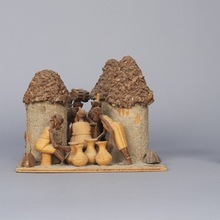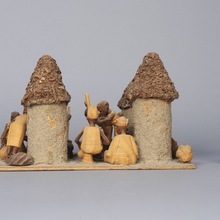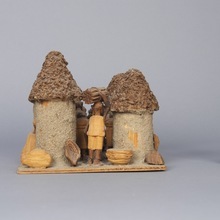Thorn Carving
MOA: University of British Columbia
3326/30
Thorn carving depicting a village scene. Figures adhered to a rectangular particle board base. Four small cylindrical huts with conical roofs are situated one in each corner. The hut walls and ground are layered with a grayish earth(?). Around the huts, eight small figures. At centre, three women, two with children on their backs, are sweeping and stirring jars. There are three male figures, one carrying wood and two seated.
-
Cultural Context
craft; tourist art
-
Specific Techniques
The light yellow-brown thorn and the dark brown thorn come from the ata tree; the light red-brown thorn comes from egun trees. The parts are glued together with viscous paste made that was made from rice cooked with water.
-
Narrative
Most of the Nigerian objects in the Lieber collection were assumed to have been collected while Jack Lieber was living in Nigeria, 1965-1970. However one of the thorn carvings was made after 1971, so the dates are uncertain.
-
History Of Use
Thorn carvings are miniatures depicting a variety of scenes from Nigerian life. The carvings first began to be made circa 1930. The thorns vary in size; they can be as large as 12.7 cm long and 9.6 cm wide. The thorn wood is comparatively soft and easy to carve; they are traditionally carved by men.
- Type of Item carving
- Culture Yoruba
- Material atum thorn, egun thorn, adhesive, wood, earth
- Manufacturing Technique carved, glued
- Measurements height 12.6 cm, width 22.3 cm, depth 15.5 cm (overall)
- Previous Owner Jack Lieber, Iris Lieber
- Received from Iris Lieber
- Made in Ibadan
- Creation Date during 1970
- Collection Date between 1965 and 1970
- Ownership Date before 2015, before June 18, 2018
- Acquisition Date on June 18, 2018
- Item Classes carvings & sculpture
- Condition fair
- Accession Number 3326/0030



